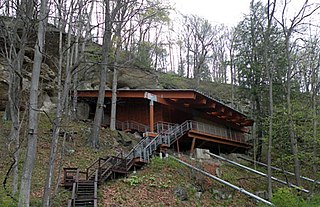
Russell Cave National Monument is a U.S. national monument in northeastern Alabama, United States, close to the city of Bridgeport. The monument was established on May 11, 1961, when 310 acres (1.3 km2) of land were donated by the National Geographic Society to the American people. It is now administered and maintained by the National Park Service. The national monument was listed on the National Register of Historic Places on October 15, 1966.

Starved Rock State Park is a state park in the U.S. state of Illinois, characterized by the many canyons within its 2,630 acres (1,064 ha). Located just southeast of the village of Utica, in Deer Park Township, LaSalle County, Illinois, along the south bank of the Illinois River, the park hosts over two million visitors annually, the most for any Illinois state park.

The Windover Archeological Site is a Middle Archaic archaeological site and National Historic Landmark in Brevard County near Titusville, Florida, United States on the central east coast of the state. Windover is a muck pond where skeletal remains of 168 individuals were found buried in the peat at the bottom of the pond. The skeletons were well preserved because of the peat. In addition, remarkably well-preserved brain tissue has been recovered from 91 skulls from the site. DNA from the brain tissue has been sequenced. The collection of human skeletal remains and artifacts recovered from Windover Pond represent among the largest finds of each type from the Archaic Period. It is considered one of the most important archeological sites ever excavated.

Pictograph Cave is an area of three caves located 5 miles (8.0 km) south of Billings, Montana, United States, preserved and protected in the 23-acre (9.3 ha) Pictograph Cave State Park.

The Meadowcroft Rockshelter is an archaeological site which is located near Avella in Jefferson Township, Pennsylvania. The site is a rock shelter in a bluff overlooking Cross Creek, and contains evidence that the area may have been continually inhabited for more than 19,000 years. If accurately dated, it would be one of the earliest known sites with evidence of a human presence and continuous human occupation in the New World.

The Koster Site is a prehistoric archaeological site located south of Eldred, Illinois. The site covers more than 3 acres and extends 30 feet down into the alluvial deposits of the Illinois River valley. Over the course of its excavation between 1969 and 1978, Koster produced deeply buried evidence of ancient human occupation from the early Archaic period to the Mississippian period. The soil strata contains a total of 25 distinct occupations each separated by additional layers of soil, making the site exceptionally well-preserved.

The Stanfield-Worley Bluff Shelter, located on private property in Colbert County in northwestern Alabama, United States, is one of the most important prehistoric sites excavated in the state due to the archeological evidence deposited by the Paleo-Indians who once occupied the rock shelter. Lying in Sanderson Cove along a tributary of Cane Creek approximately seven miles (11 km) south of the Tennessee Valley, the shelter and the high bluffs of the surrounding valley provided a well-protected environment for the Native American occupants.

The Lindenmeier site is a stratified multi-component archaeological site most famous for its Folsom component. The former Lindenmeier Ranch is in the Soapstone Prairie Natural Area, in northeastern Larimer County, Colorado, United States. The site contains the most extensive Folsom culture campsite yet found with calibrated radiocarbon dates of c. 12,300 B.P.. Artifacts were also found from subsequent Archaic and Late pre-historic periods.

Hampson Archeological Museum State Park is a 5-acre (2.0 ha) Arkansas state park in Mississippi County, Arkansas in the United States. The museum contains a collection of archeological artifacts from the Nodena site, which is a former Native American village on the Mississippi River between 1400 and 1650. James K. Hampson began excavating the site in the 1920s, a museum was built in 1946 and the Arkansas General Assembly officially accepted the collection of artifacts from the Hampson family on March 30, 1957. The park first opened in 1961 as Hampson Museum State Park and has since been renamed.
Hester Site is a major prehistoric archaeological site in Monroe County, Mississippi. It is a multicomponent site whose major occupation took place during the Archaic period with artifacts dating from 9000 to 8000 BCE, and other occupations during the Woodland and Mississippian periods. The site is one of the largest Archaic sites in the southeastern United States, and its well-stratified nature was critical in providing for accurate relative dating of finds at other sites throughout the region. The site was declared a National Historic Landmark in 2001.

The Abbott Farm Historic District is a National Historic Landmark archaeological site in New Jersey. It is the largest known Middle Woodland village of its type on the East Coast of the United States. Significant evidence suggests that the Delaware River floodplain was occupied by Paleoindian people for a long period. It was inhabited between 500 BC and 500 AD. It has been a source of controversy and debate around early development.

The Sommerheim Park Archaeological District includes a group of six archaeological sites west of Erie, Pennsylvania in the United States. The sites are in Sommerheim Park, one of the few undeveloped areas of the Lake Erie shoreline, in Millcreek Township. This district has been listed on the National Register of Historic Places. This is one of the leading archaeological sites in the Erie area and along the southern shoreline of Lake Erie, due to the amount of artifacts and the lack of disturbance on the site.

The LoDaisKa site is a prominent archaeological site in the U.S. state of Colorado, located within a rockshelter near Morrison. The rockshelter was first inhabited by people of the Archaic through the Middle Ceramic period, generally spanning 3000 BC to 1000 AD.

Franktown Cave is located 25 miles (40 km) south of Denver, Colorado on the north edge of the Palmer Divide. It is the largest rock shelter documented on the Palmer Divide, which contains artifacts from many prehistoric cultures. Prehistoric hunter-gatherers occupied Franktown Cave intermittently for 8,000 years beginning about 6400 BC The site held remarkable lithic and ceramic artifacts, but it is better known for its perishable artifacts, including animal hides, wood, fiber and corn. Material goods were produced for their comfort, task-simplification and religious celebration. There is evidence of the site being a campsite or dwelling as recently as AD 1725.
Hell Gap is a deeply stratified archaeological site located in the Great Plains of eastern Wyoming, approximately thirteen miles north of Guernsey, where an abundant amount of Paleoindian and Archaic artifacts have been found and excavated since 1959. This site has had an important impact on North American archaeology because of the large quantity and breadth of prehistoric Paleoindian and Archaic period artifacts and cultures it encompasses. It was designated a National Historic Landmark in 2016.

The Paine Run Rockshelter (44-AU-158) is an archaeological site in Shenandoah National Park, in Augusta County, Virginia, United States.

The Hidden Valley Rock Shelter (44-BA-31) is a significant archaeological site located near the community of Warm Springs in Bath County, Virginia, United States. A large rockshelter located near the Jackson River, it has been occupied by humans for thousands of years, and it has been named a historic site.

The Moccasin Bluff site is an archaeological site located along the Red Bud Trail and the St. Joseph River north of Buchanan, Michigan. It was listed on the National Register of Historic Places in 1977, and has been classified as a multi-component prehistoric site with the major component dating to the Late Woodland/Upper Mississippian period.
The King Coulee Site is a prehistoric Native American archaeological site in Pepin Township, Minnesota, United States. It was listed on the National Register of Historic Places in 1994 for having state-level significance in the theme of archaeology. It was nominated for being a largely undisturbed occupation site with intact stratigraphy and numerous biofacts stretching from the late Archaic period to the Oneota period. This timeframe spans roughly from 3,500 to 500 years ago. The site yielded the oldest known evidence of domesticated plants in Minnesota: seeds dated to 2,500 years ago from the squash Cucurbita pepo.
Melvin L. Fowler was an American archaeologist, author, and the primary expert on the Cahokia mounds, the largest ancient metropolis in North America. Published books include Cahokia, the Great Native American Metropolis and The Cahokia Atlas: A Historical Atlas of Cahokia Archaeology.

















